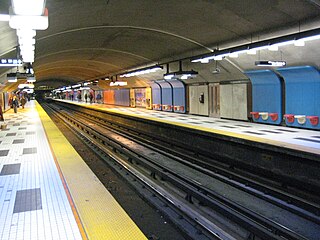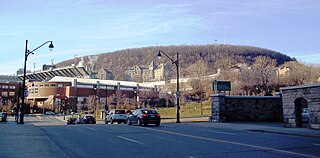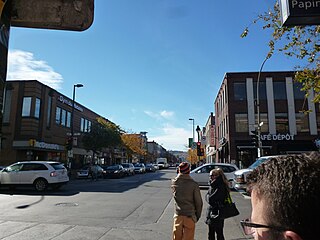
Robert Bourassa was a Canadian lawyer and politician who served as the 22nd premier of Quebec from 1970 to 1976 and from 1985 to 1994. A member of the Liberal Party of Quebec, he served a total of just under 15 years as premier. Bourassa's tenure was marked by major events affecting Quebec, including the October Crisis and the Meech Lake and Charlottetown Accords.

Notre-Dame-de-Grâce, commonly known as NDG, is a residential neighbourhood of Montreal in the city's West End, with a population of 166,520 (2016). An independent municipality until annexed by the City of Montreal in 1910, NDG is today one half of the borough of Côte-des-Neiges–Notre-Dame-de-Grâce. It comprises two wards, Loyola to the west and Notre-Dame-de-Grâce to the east. NDG is bordered by four independent enclaves; its eastern border is shared with the City of Westmount, Quebec, to the north and west it is bordered by the cities of Montreal West, Hampstead and Côte-Saint-Luc. NDG plays a pivotal role in serving as the commercial and cultural hub for Montreal's predominantly English-speaking West End, with Sherbrooke Street West running the length of the community as the main commercial artery. The community is roughly bounded by Claremont Avenue to the east, Côte-Saint-Luc Road to the north, Brock Avenue in the west, and Highway 20 and the Saint-Jacques Escarpment to the south.

The Orange Line, also known as Line 2, is the longest and first-planned of the four subway lines of the Montreal Metro in Montreal, Quebec, Canada. It formed part of the initial network, and was extended from 1980 to 1986. On April 28, 2007, three new stations in Laval opened making it the second line to leave Montreal Island.

Henri-Bourassa station is a Montreal Metro station in the borough of Ahuntsic-Cartierville in Montreal, Quebec, Canada. It is operated by the Société de transport de Montréal (STM) and serves the Orange Line. It is located in the Ahuntsic district. The station opened October 14, 1966, as part of the original network of the Metro. It was the eastern terminal of the Orange Line until 2007, when the line expanded to Montmorency station in Laval.

Plamondon station is a Montreal Metro station in the borough of Côte-des-Neiges–Notre-Dame-de-Grâce in Montreal, Quebec, Canada. It is operated by the Société de transport de Montréal (STM) and serves the Orange Line. It is located in the Snowdon neighbourhood of Côte-des-Neiges–Notre-Dame-de-Grâce. It opened on June 29, 1982 and replaced Côte-Sainte-Catherine station as the Orange Line's western terminus until the extension to Du Collège station was completed in 1984.

The Société de transport de Montréal is a public transport agency that operates transit bus and rapid transit services in the urban agglomeration of Montreal, Quebec, Canada. Established in 1861 as the "Montreal City Passenger Railway Company", it has grown to comprise four subway lines with a total of 68 stations, as well as 212 bus routes and 23 night routes. The STM was created in 2002 to replace the Société de transport de la communauté urbaine de Montréal. The STM operates the most heavily used urban mass transit system in Canada, and one of the most heavily used rapid transit systems in North America. As of 2019, the average daily ridership is 2,297,600 passengers: 977,400 by bus, 1,306,500 by rapid transit and 13,700 by paratransit service.

Ville-Marie is the name of a borough (arrondissement) in the centre of Montreal, Quebec. The borough is named after Fort Ville-Marie, the French settlement that would later become Montreal, which was located within the present-day borough. Old Montreal is a National Historic Site of Canada.

Villeray–Saint-Michel–Parc-Extension is a borough (arrondissement) in the city of Montreal, Quebec. It had a population of 143,853 according to the 2016 Census and a land area of 16.5 square kilometres (6.4 sq mi).

Du Ruisseau station is a future Réseau express métropolitain (REM) station in Montreal, Quebec, Canada, expected to open for REM service by the end of 2024. It was formerly a commuter rail station on the Deux-Montagnes line until Exo ended service in 2020.

Bois-Franc station is a future Réseau express métropolitain (REM) interchange station in the Bois-Franc neighbourhood of Montreal, Quebec, Canada. REM service is expected to begin at the station in the fourth quarter of 2024.

Le Plateau-Mont-Royal is a borough (arrondissement) of the city of Montreal, Quebec, Canada.

The Montreal Metro is a rubber-tired underground rapid transit system serving Greater Montreal, Quebec, Canada. The metro, operated by the Société de transport de Montréal (STM), was inaugurated on October 14, 1966, during the tenure of Mayor Jean Drapeau.

Park Extension is a neighbourhood in the city of Montréal, Québec. It is located in the borough of Villeray–Saint-Michel–Parc-Extension and has a population of 33,800 and an area of 1.6 km2. The name derives from the fact that it is situated at the north end of Park Avenue and is literally an "extension" of the artery. The area is known by locals as "Park Ex."

Bois-de-Boulogne station is a commuter rail station operated by Exo in Montreal, Quebec, Canada. It is served by the Saint-Jérôme line.

Pine Avenue is an east–west street in Montreal, Quebec, Canada. This street serves as the dividing line between the downtown Ville-Marie borough and borough of Le Plateau-Mont-Royal, and also serves as the northern border of the Golden Square Mile historic district, further west.

Papineau Avenue is the longest north–south street in Montreal, Quebec, Canada. The part of the street between Henri Bourassa Boulevard and Quebec Autoroute 40 is the Montreal portion of Quebec Autoroute 19, commonly referred to as Autoroute Papineau. North of Henri Bourassa Boulevard, it becomes a true autoroute before crossing the Rivière des Prairies on the Papineau-Leblanc Bridge. In the south, the avenue ends at Notre-Dame Street.
Montreal has a developed transport infrastructure network, which includes well-developed air, road, rail, and maritime links to the rest of Canada, as well as the United States and the rest of the world. Local public transport includes a metro system, buses, ferry services and cycling infrastructure.

Parc station, also known as Park Avenue station and formerly Jean-Talon station, is a historic railway station building in Montreal, Quebec, Canada. Its western end currently houses the Montreal Metro's Parc station, while businesses occupy the rest of the building. Although the main building no longer serves the railway, the Exo commuter rail Parc station is adjacent to it. It is located on Jean-Talon Street at the end of Park Avenue in the Park Extension neighbourhood of the borough of Villeray–Saint-Michel–Parc-Extension.

D'Iberville Street is a north-south thoroughfare of Montreal.

















